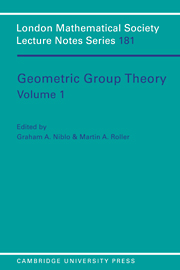Book contents
- Frontmatter
- Contents
- Preface
- List of Participants
- 1 Group Actions and Riemann Surfaces
- 2 The Virtual Cohomological Dimension of Coxeter Groups
- 3 The Geometric Invariants of a Group A Survey with Emphasis on the Homotopical Approach
- 4 String Rewriting — A Survey for Group Theorists
- 5 One Relator Products and High-Powered Relators
- 6 An Inaccessible Group
- 7 Isoperimetric and Isodiametric Functions of Finite Presentations
- 8 On Hibert's Metric for Simplices
- 9 Software for Automatic Groups, Isomorphism Testing and Finitely Presented Groups
- 10 Proving Certain Groups Infinite
- 11 Some Applications of Small Cancellation Theory to One-Relator Groups and One-Relator Products
- 12 A Group Theoretic Proof of the Torus Theorem
- 13 N-Torsion and Applications
- 14 Surface Groups and Quasi-Convexity
- 15 Constructing Group Actions on Trees
- 16 Brick's Quasi Simple Filtrations and 3-Manifolds
- 17 A Note on Accessibility
- 18 Geometric Group Theory 1991 Problem List
16 - Brick's Quasi Simple Filtrations and 3-Manifolds
Published online by Cambridge University Press: 15 March 2010
- Frontmatter
- Contents
- Preface
- List of Participants
- 1 Group Actions and Riemann Surfaces
- 2 The Virtual Cohomological Dimension of Coxeter Groups
- 3 The Geometric Invariants of a Group A Survey with Emphasis on the Homotopical Approach
- 4 String Rewriting — A Survey for Group Theorists
- 5 One Relator Products and High-Powered Relators
- 6 An Inaccessible Group
- 7 Isoperimetric and Isodiametric Functions of Finite Presentations
- 8 On Hibert's Metric for Simplices
- 9 Software for Automatic Groups, Isomorphism Testing and Finitely Presented Groups
- 10 Proving Certain Groups Infinite
- 11 Some Applications of Small Cancellation Theory to One-Relator Groups and One-Relator Products
- 12 A Group Theoretic Proof of the Torus Theorem
- 13 N-Torsion and Applications
- 14 Surface Groups and Quasi-Convexity
- 15 Constructing Group Actions on Trees
- 16 Brick's Quasi Simple Filtrations and 3-Manifolds
- 17 A Note on Accessibility
- 18 Geometric Group Theory 1991 Problem List
Summary
Abstract. Poénaru [P] and Casson have developed an idea about the metric geometry of the Cayley graph of a group having to do with certain problems in 3-manifold theory; this is described in [G] and in [GS]. Brick [B] has developed a non-metric condition related to this, which he calls “quasi simple filtration”; a space is qsf if it is, approximately, the union of an increasing sequence of compact, 1-connected spaces. Here we outline these notions and establish the theory in a polyhedral setting. This provides a purely group-theoretic notion of qsf which seems interesting in itself.
Polyhedral niceties
Basic facts: The theory of finite polyhedra is a standard subject; one reference is [AH], Chapter 3. The constructions in Whitehead's paper [W] involve simplicial complexes and subdivisions of particular sorts, and this too can be considered a polyhedral reference. We shall outline some of the theory here.
A finite polyhedron P is a subset of some real vector space which can be triangulated by a finite simplicial complex K whose realization is P = |K|. It is sometimes more convenient to consider a cell-structure C by finitely many convex open cells of various dimensions; each such is the bounded intersection of a finite number of open half-spaces with an affine subspace; the cells in such a structure are disjoint, and the boundary of any cell is a finite union of other cells; such a structure has a triangulation obtained by a “barycentric subdivision” C′; a vertex is put in each cell, and a set of these form the vertices of a simplex exactly when their corresponding cells are totally ordered by the relation “is in the boundary of”.
- Type
- Chapter
- Information
- Geometric Group Theory , pp. 188 - 203Publisher: Cambridge University PressPrint publication year: 1993
- 8
- Cited by



